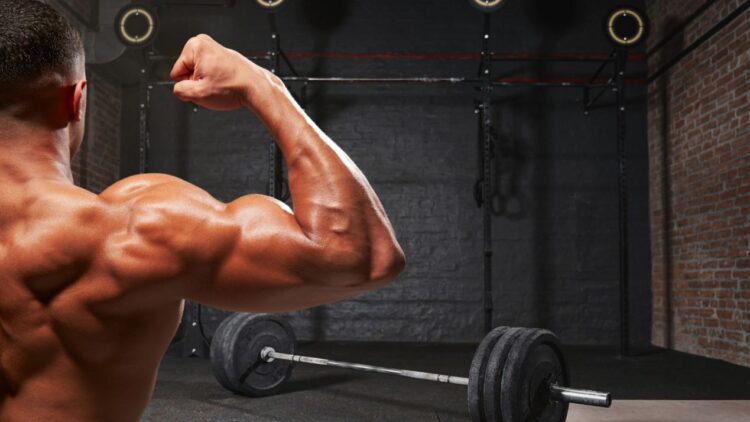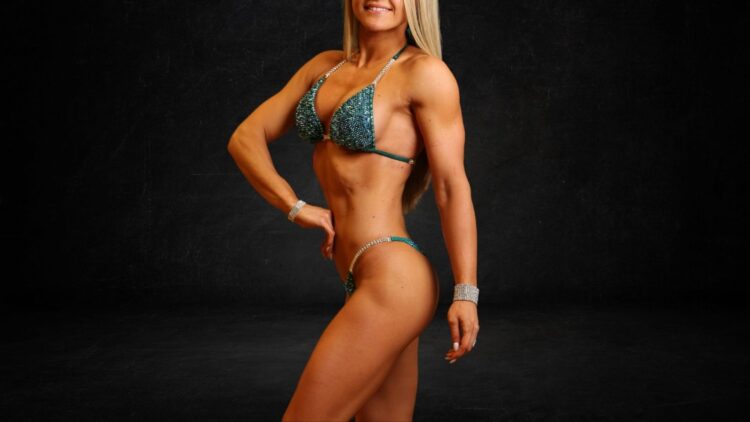
OBJECTIVE OF BODYBUILDING: Earn the most favor with a panel of judges by showcasing an impressive level of muscularity through various posing routines.
NUMBER OF PLAYERS: 2+ players
MATERIALS: Posing trunks, tan, big guns (muscles)
TYPE OF GAME: Sport
AUDIENCE: 18+
OVERVIEW OF BODYBUILDING
Bodybuilding refers to the practice of lifting weights and dieting in a way that promotes maximum muscle growth and definition. As a sport, competitive bodybuilding competitions feature several bodybuilders performing posing routines on a stage to impress a panel of judges.
The intrigue of bodybuilding started far back with the Ancient Greeks. Through chiseled sculptures, Greek statues often featured figures with well-developed muscles, defined abdominals, and overall aesthetic features. Furthermore, there is also evidence the Ancient Greeks and Egyptians held stone-lifting competitions as a way to showcase feats of strength. However, it wouldn’t be until the late 1800s that this practice of lifting heavy weights simply for the purpose of entertainment would gain popularity.
Apart from these early exhibitions of strength, one German man named Eugen Sandow started capitalizing on the physique he developed from his strength training. In the late 1800s, Sandow started hosting “muscle display performances”, which were shows that involved muscular men showcasing their impressive bodies while doing feats of strength or wrestling. However, Sandow’s flexing and posing performances started becoming so popular that he had now garnered an audience that allowed him to create the first commercially available exercise equipment in history: dumbbells, tension bands, and pulley systems.
Despite Sandow organizing the first-ever bodybuilding competition in 1901, the sport didn’t gain much momentum until the 1950s. In the late 1960s, the most influential man in bodybuilding history, Arnold Schwarzenegger, took the sport by storm. Due in part to his popularity as an actor, Schwarzenegger introduced much of the Western world to the sport of bodybuilding and lifting weights.
The modern popularity of bodybuilding can be largely attributed to the contributions of Arnold Schwarzenegger. However, as the decades have passed, fitness as a whole has gained a massive new audience. Nowadays, especially in the United States, going to the gym has become so common that it is almost unheard of to hear about anyone who has never stepped foot in one. With the dawn of social media and Youtube, fitness content has only become more lucrative over the years. Because of this, the younger generation has arguably become more bodybuilding-obsessed than any previous generation. As a result, it is only safe to assume that the sport of bodybuilding will continue to grow in the coming decades.
SETUP

EQUIPMENT
- Posing trunks/bikini: With the purpose of a bodybuilding competition being to showcase the many muscles of the body, most competitors will wear the bare minimum required. For men, this is often in the form of posing trunks, which are tight, underwear-like pieces of clothing for the lower body. In certain bodybuilding competitions, men will wear board shorts or swimming trunks. Women will wear bikini-like attire.
- Tan: In order to best showcase muscle definition on stage, bodybuilders must tan if they wish to be competitive. This is usually done with the help of a spray tan, which they’ll spray on backstage before the competition.
TRAINING
Bodybuilding is as much a lifestyle as it is a sport. In order to be competitive, a bodybuilder must spend years lifting weights and learning how to diet to build and sculpt their body. Interestingly, bodybuilding is one of the few sports where maturity is almost always an advantage, at least up to a certain point. This is because a 40-year-old bodybuilder has had much more time to develop matured muscle mass and learn how various forms of training and dieting affect their body than a 20-year-old would have.
A bodybuilder must always be on top of their training and dieting. They must consistently lift weights, eat in a way that supports their current goals (such as gaining or losing weight), practice their posing routines, stay on top of their health, and always be mindful of their physical and mental recovery. Additionally, bodybuilders must structure their routines to reach peak shape just in time for competition day.
CUTTING WATER WEIGHT
In addition to building muscle and cutting fat, body builders also often dehydrate themselves for 12-24 hours before a competition to cut water weight. This dehydration helps make the bodybuilder’s muscles more defined. That said, this is an extremely dangerous practice and is looked down upon by many health and fitness professionals.
DIVISIONS
Competitive bodybuilding shows feature several divisions and competitions. These include open division, natural bodybuilding, men’s physique, classic physique, and female bodybuilding divisions.
OPEN DIVISION
Open division is considered the “main” bodybuilding division and typically generates the most interest. In this division, the goal is to build the most muscle mass humanly possible while remaining extremely cut and lean. In this division, some competitors weigh nearly 300 pounds on competition day of pure muscle, with every muscle fiber on their body visible.
NATURAL BODYBUILDING
Natural bodybuilding competitions are those that strictly prohibit the use of steroids and other performance-enhancing drugs. In all other bodybuilding competitions and divisions, steroid use is almost necessary to compete at higher levels. As a result of outlawing the use of performance-enhancing compounds, natural bodybuilders tend to have much more “realistic” physiques or ones that are still impressive but not to an extreme or freakish level.
MEN’S PHYSIQUE
Men’s physique is a bodybuilding division in which competitors wear board (swim) trunks that cover their upper legs. Because of this, men’s physique is focused almost entirely on upper body aesthetics.
CLASSIC PHYSIQUE
Classic physique is a division of bodybuilding that is a toned-down version of the open division. Competitors still build freakishly impressive physiques, but they focus more on overall image, proportions, and aesthetics than on building as much muscle mass as possible. Classic physique focuses on bodybuilding physiques that closely resemble those from the early bodybuilding days of the 70s and 80s, hence the “classic” part of its name.
FEMALE BODYBUILDING

Female bodybuilding includes a number of its own divisions, some of which are the same as the men’s divisions. However, female bodybuilding has always remained in the shadow of men’s bodybuilding. A major reason for this disparity in popularity is the fact that female bodybuilding is still largely focused on attaining unnatural amounts of muscle mass. While men desire large amounts of muscle, the same cannot be said for most women regarding the steroid-enhanced levels of muscle seen with female bodybuilders.
As a result, the “bikini division” of female bodybuilding has garnered the most popularity, as competitors build physiques that are much more “natural” in spectators’ eyes, with the added bonus of being healthier to attain.
GAMEPLAY
COMPETITION FORMAT/SHOW DAY
PREJUDGING
Bodybuilding shows are usually all-day events. Competitors arrive early in the morning for the “prejudging”, which acts as a rehearsal for the actual show. The prejudging show is devoid of most fans but still features a full judging panel, and all competitors must go through their full show-time routines. These routines include:
1) Symmetry Round: Competitors line up side-by-side on stage with their hands down by their sides in a “relaxed” stance. Judges will periodically call out a command for the competitors to rotate 90 degrees to one side, eventually resulting in them doing a full circle so that the judges can see their entire physique.
2) Compulsory Poses: Competitors must complete a series of seven static poses (five for women). Usually, these are done side-by-side on stage, but they’re also done individually, with one competitor being called onto the stage at a time. These poses include:
- Front double biceps
- Front lat spread (men only)
- Side chest
- Side triceps
- Back double biceps
- Back lat spread (men only)
- Abdominals and thighs
3) Individual Routine: Competitors have three minutes to perform a personalized posing routine to a musical track. Each competitor choreographs their own routine, including picking the music.
In many cases, the prejudging allows the judges to already have a solid idea of the final placements before the actual show even begins.
MAIN SHOW
The actual bodybuilding show usually takes place in the evening in front of a large crowd. Competitors perform the same routines as they did in prejudging: the symmetry round, compulsory poses, and an individual routine. However, at the end of the show, the judges will invite the top few competitors back on the stage for a “pose down”. These finalists, now only in the company of the best competitors, perform one last series of their poses. Judges will move each competitor around, placing different ones next to each other for better comparison.
At the end of the pose down, the final rankings of the competitors will be announced.
SCORING
Bodybuilding shows are scored by a panel of five to nine judges between five and nine. In each round, the judges will individually rank each competitor in order of excellence, from 1 to x (the x depending on the number of competitors), with 1 being the best. Each competitor’s highest and lowest judging scores are omitted, and the rest are added together.
END OF GAME
The competitor who receives the lowest overall score from the judges (meaning they placed highly in each round) wins the bodybuilding show.
- 30 GAMES TO PLAY OVER TEXT - April 22, 2024
- 20+ FREE PRINTABLE BABY SHOWER GAMES - April 16, 2024
- 20+ College Party Games for the Best Night Ever! - April 2, 2024